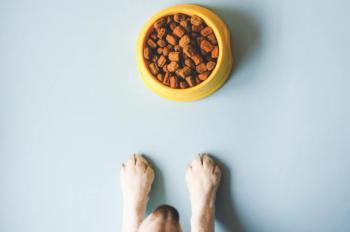
USDA grant propels PRRS research
The role of insects in the virus' spread among farms is being examined.
ST. PAUL, MINN.—The University of Minnesota's (UM) College of Veterinary Medicine has received $4.4 million to study porcine reproductive and respiratory syndrome (PRRS), a viral disease that affects more than 60 percent of U.S. swine farms.
PRRS manifests in two clinical phases: reproductive failure and postweaning respiratory diseases. The piglet shown at the bottom is infected with PRRS.
The grant reportedly is the largest ever awarded by the United States Department of Agriculture's (USDA) Cooperative States Research, Education and Extension Service (CSREES), making the university a center for PRRS research. In addition, the university plays a key role nationally by helping to coordinate PRRS researchers at other universities worldwide with further funding in excess of $4 million from the National Pork Board, the USDA National Research Initiative, state pork producer associations and veterinary biologics companies.
"PRRS is the most important disease of pigs worldwide," says Dr. Michael Murtaugh, principal investigator and UM professor of veterinary pathobiology. "It is caused by an arterivirus that infects only pigs, although related viruses infect mice, horses and certain monkeys. Infection of late-term pregnant sows causes abortion and weak-born pigs. Infection of young and growing pigs results in a mild pneumonia but is associated with other respiratory and intestinal infections that severely reduces pig health and growth."
PRRS has been recognized as a disease of pigs for 15 years, adds Murtaugh, who has been researching the virus since 1992.
Silent killer
There is no way to detect PRRS infection with routine monitoring in susceptible animals before the disease is manifested. Some forms of the virus produce no significant signs. Other forms, however, are highly virulent, making infected animals lethargic, causing loss of appetite, reduced growth and death. Baby pigs are at increased risk for secondary infection. Sows infected early in pregnancy tend to recover without serious disease, but infection in the last three months of gestation results in widespread abortion and weak-born piglets with a poor prognosis for survival, Murtaugh says.
Economic loss from dead animals, reduced growth rates, higher treatment costs and secondary bacterial and viral infections can be devastating to swine producers, Murtaugh adds. Farms also can suffer recurrent infections despite the best available advice and good health practices.
"The combination of emotional and financial stress has ruined many farm families," Murtaugh says.
A positive diagnosis of PRRS usually is based on clinical signs and detection of antibodies to PRRS virus in serum by an ELISA test, which is similar to a Lyme disease test. Detection of PRRS before clinical signs are apparent is difficult, requiring a genetic test that is not currently used in routine disease monitoring.
No drugs are available to treat PRRS after a pig is infected. "Even if there was a drug, it likely would not be economically feasible to use," Murtaugh says.
Animals that recover from natural PRRS virus infections are immune to reinfection. However, the virus is genetically variable, and protection is not always complete. Vaccines behave the same way, providing a high level of protection in some cases and incomplete protection in other cases.
At present, it is not possible to predict how a particular PRRS virus will behave on a farm and how completely pigs will be protected against it by vaccination.
Pigs are the only animals susceptible to PRRS. People are not affected by consuming pork from an animal with the virus, Murtaugh says.
Two forms
There are two genetic forms of the PRRS virus and early in the history of the disease, one was distributed in Europe and the other in North America. Both forms of the virus appeared at the same time even though they are distinct.
Murtaugh hypothesizes that PRRS evolved from its most closely related arterivirus in mice hundreds of years ago in Europe, before pigs were introduced to North America.
It appears that arteriviruses in mice and horses are transmitted horizontally in semen at the time of mating, and vertically from mother to offspring. Pigs historically were raised at low densities, so the rate of transmission of PRRSV might have been low, and its rate of genetic change could have been slow, albeit independent in Europe and North America. The appearance of PRRS coincided with changes in swine husbandry to high-density confinement in both Europe and North America.
PRRS could have changed from an inapparent reproductive disease of low incidence to a readily transmitted reproductive and respiratory disease due to its rapid transmission among animals in close contact, while the mixing of pigs in current management systems has increased the rate of viral evolution by facilitating genetic mixing and recombination. PRRS now is spread most commonly by pig-to-pig contact and from sow to piglet during gestation. Airborne transmission appears to be infrequent.
University of Minnesota scientists are well known for their expertise in PRRS disease research from their work on viral genetics, immunology and epidemiology previously conducted at the University's College of Veterinary Medicine. For example, basic studies in immunology are being used to improve vaccines and diagnostic tests for PRRS. In order to investigate problems and confirm findings at the university, animals are given the virus and their immune responses to it are measured.
The level of protection the animal achieves with different vaccine treatments is measured, and the response to challenge with a virulent PRRS virus is observed.
Second study
In another study, scientists are using epidemiology to understand how the virus spreads among farms where there is no evidence of pig-to-pig contact. Experiments are carried out in research settings and on pig farms. The role of insects in the virus' spread among farms is being examined, as is the role of transport vehicles.
Outlook
At this point, Murtaugh says, there are more theories and ideas than answers to the problem of PRRS. The nature of the virus and the disease it causes has changed over time.
"The viruses in the field today are different than the viruses present 10 years ago; European and North American genetic types are more widespread, and the disease appears to becoming more virulent," Murtaugh reports. Making progress on diagnosis and prevention of PRRS requires close cooperation among PRRS researchers, sufficient resources to accelerate research, and involvement of producers, veterinarians and allied industries. The University of Minnesota looks forward to participating actively in this endeavor and values the support and commitment of the USDA CSREES.
Newsletter
From exam room tips to practice management insights, get trusted veterinary news delivered straight to your inbox—subscribe to dvm360.






